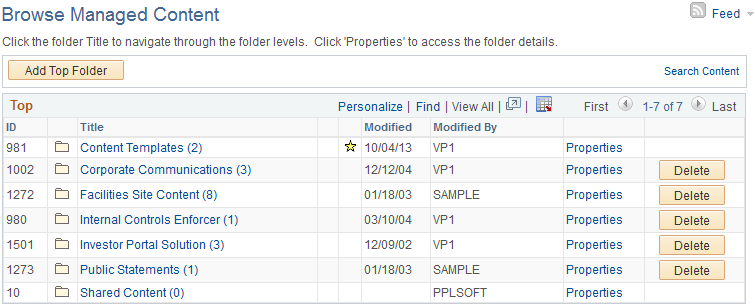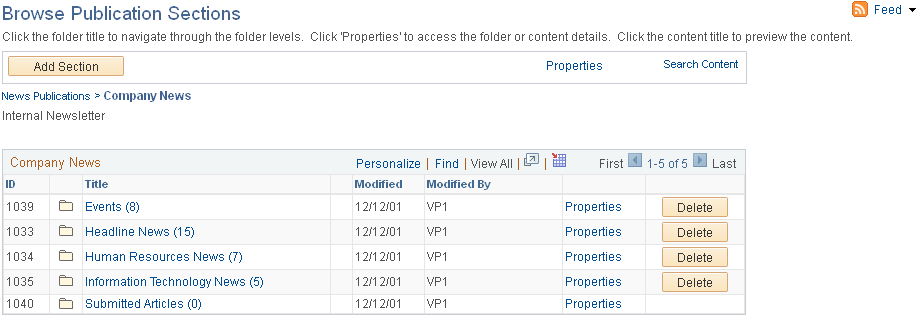Browsing Folder Hierarchies
This section discusses using top level browse pages and browsing sub-level Managed Content.
Note: Defining folder properties and setting up their privilege security is not discussed in this chapter because too many variations exist between features.
|
Page Name |
Definition Name |
Navigation |
Usage |
|---|---|---|---|
|
Browse Content |
EPPCM_HIERTOP_MAIN |
|
Add a top-level folder if you are a top administrator for this feature or, starting at the top level folders, drill down through folder hierarchies for content that is accessible by that feature. |
|
Browse Managed Content Browse Categorized Content Browse Publication Sections |
EPPCM_HIER_MAIN |
|
For Managed Content and Categorized Content, drill down through the folders containing managed content or categorized content. For News Publications, access the Browse Section Articles page. |
|
EPPCM_HIERNWS_MAIN |
Click a section that has no children on the Browse Publication Sections page. |
Displays basic information about the articles within a single section of a news publication and provides access to article details. You can add, edit, delete, or view articles depending upon article status and member privileges for the section. |
Folder hierarchies and content within Content Management undergo frequent changes. Content is constantly being created, updated, published, relocated, and deleted. Content Management reflects these changes as they occur.
The Browse Folder or Browse Publications menu items are used to start browsing at the top of each content management hierarchy. From there, depending on the feature being browsed, the Browse Managed Content, Browse Categorized Content, Browse News Publication, or Browse Publication Sections page is used to continue browsing through the content hierarchy.
The following rules apply to all Content Management features:
A portal name of the child folder must match the portal name of the parent folder.
A feature type of the child folder must match the feature type of the parent folder.
A folder can have only one parent.
A folder with itself as the parent is a Top Folder.
Content can have multiple parent folders.
Content has a single origin feature type.
Managed Content folders can contain only Managed Content type content.
All non-Managed Content folders can contain only their own feature type content or Managed Content type content.
Content originating from a feature type that is different from the one it is being accessed from can only be viewed unless it has been shared to the Managed Content type.
Use the Browse Content page (EPPCM_HIERTOP_MAIN) to add a top-level folder if you are a top administrator for this feature or, starting at the top level folders, drill down through folder hierarchies for content that is accessible by that feature.
Navigation:
This example illustrates the fields and controls on the Example of a top-level Browse Managed Content page.

Note: The Content Templates folder holds the templates that are available in the RTE. For more information about creating the Content Template folder, see “Creating Content Template Folder”.
Alternatively, access the Browse News Publications page (select
This example illustrates the fields and controls on the Browse News Publications page. You can find definitions for the fields and controls later on this page.

Field or Control |
Description |
|---|---|
Feed |
Click to open the feed for this item, if available. See Publishing PeopleSoft Interaction Hub Content as a Feed. |
Add Top Folder |
Click to create new folder hierarchies or publications. |
Search Content |
Click to access the Maintain Content page to access and maintain the properties for the content that you have privileges to view. |
Title |
Click to drill down through the folder hierarchy. The bracketed number indicates the number of folders and documents that are located at the next level. This number does not distinguish between folders and documents. |
|
Indicates folder that contains recently added contents. |
Modified |
Displays the date when the content folder was last modified. |
Modified By |
Displays the user ID who last modified the content folder. |
Properties |
Click to go to the Folder Properties page to view or edit property details and security for this folder hierarchy. |
Delete |
Click to delete the associated folder. Note: Deleting a folder is allowed only if the folder does not contain any published content. Deleting the folder will cascade the deletion to all of the folder's sub-folders and child content. The Shared Content folder is a system folder and cannot be deleted. |
Creating Template in the Content Template Folder
The Content Template folder holds the templates that are available in the RTE.
Click Content Templates folder.
Click Add Content.
From the Content Type list, select Text or HTML and then click OK.
Use the Browse Managed Content page (EPPCM_HIER_MAIN) to for Managed Content and Categorized Content, drill down through the folders containing managed content or categorized content.
For News Publications, access the Browse Section Articles page.
Navigation:
Click a folder title link on the Browse Managed Content page.
Click a folder title link on the Browse Categorized Content page.
Click a section title link on the Browse News Publications page.
This example illustrates the fields and controls on the Example of a sublevel Browse Managed Content page.

Alternatively, access the sublevel Browse News Publications page (select and click a folder title link).
This example illustrates the fields and controls on the Example of the Browse Publication Sections page. You can find definitions for the fields and controls later on this page.

Sublevel Browse Managed Content and Browse Categorized Content pages display basic information about the folders and the content within a folder. Within a top folder or a subfolder, you can add a subfolder, add content, or navigate deeper into the folder hierarchy. Beneath the root folder (Top), locator links enable you to traverse back up the folder hierarchy. A description of the content appears below the locator links. This description can include HTML that is entered in the summary on the Folder Properties page.
This page provides drill-down access to subfolders as well as a navigation path to return to the top level. Depending on member privileges for the folder, you can add, edit, delete, or view subfolders and content.
Note: Managed Content and Categorized Content hierarchies may contain many subfolder levels.
Depending on the feature, Content Management enables you to add different types of content, such as file attachments, web URLs, text, HTML, and image attachments. Based on the type of content that you select, you have a choice of format; for instance, the format for a file attachment can be Microsoft Word or Adobe Acrobat. The image to the left of the title identifies the format that is used for each content item.
Field or Control |
Description |
|---|---|
Feed |
Click to open the feed for this item, if available. See Publishing PeopleSoft Interaction Hub Content as a Feed. |
Add Folder |
Click to access the Folder Properties page to add a new subfolder. |
Add Section |
Click to access the Browse Managed Content - Add Content page, where you can specify the type of content you want to add to a folder in managed content. |
Add Content |
Click to access the Folder Properties page, where you can define the folder properties and details for child content. Note: Child content created from this folder uses the specified child default values. |
Properties |
Click to access the Folder Properties page to view or edit property details and security for this folder hierarchy. |
Search Content |
Click to access the Maintain Content page to access and maintain the properties for the content that you have privileges to view. |
Corporate Communications
Field or Control |
Description |
|---|---|
ID |
Displays the content IDs that exist in the selected content folder. |
Title |
Click the content title link to view the content details. |
Modified |
Displays the date when the content was last modified. |
Modified By |
Displays the user ID who last modified the content. |
Properties |
Click to access the content properties page to view or edit property details for this content. |
Delete |
Click to delete the associated content. |
